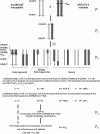Fine mapping of the sunflower resistance locus Pl(ARG) introduced from the wild species Helianthus argophyllus
- PMID: 20700574
- PMCID: PMC2963734
- DOI: 10.1007/s00122-010-1416-4
Fine mapping of the sunflower resistance locus Pl(ARG) introduced from the wild species Helianthus argophyllus
Abstract
Downy mildew, caused by Plasmopara halstedii, is one of the most destructive diseases in cultivated sunflower (Helianthus annuus L.). The dominant resistance locus Pl(ARG) originates from silverleaf sunflower (H. argophyllus Torrey and Gray) and confers resistance to all known races of P. halstedii. We mapped Pl(ARG) on linkage group (LG) 1 of (cms)HA342 × ARG1575-2, a population consisting of 2,145 F(2) individuals. Further, we identified resistance gene candidates (RGCs) that cosegregated with Pl(ARG) as well as closely linked flanking markers. Markers from the target region were mapped with higher resolution in NDBLOS(sel) × KWS04, a population consisting of 2,780 F(2) individuals that does not segregate for Pl(ARG). A large-insert sunflower bacterial artificial chromosome (BAC) library was screened with overgo probes designed for markers RGC52 and RGC151, which cosegregated with Pl(ARG). Two RGC-containing BAC contigs were anchored to the Pl(ARG) region on LG 1.
Figures


Similar articles
-
Genetics and mapping of a novel downy mildew resistance gene, Pl(18), introgressed from wild Helianthus argophyllus into cultivated sunflower (Helianthus annuus L.).Theor Appl Genet. 2016 Apr;129(4):741-752. doi: 10.1007/s00122-015-2662-2. Epub 2016 Jan 8. Theor Appl Genet. 2016. PMID: 26747047
-
Genotyping-by-sequencing targeting of a novel downy mildew resistance gene Pl 20 from wild Helianthus argophyllus for sunflower (Helianthus annuus L.).Theor Appl Genet. 2017 Jul;130(7):1519-1529. doi: 10.1007/s00122-017-2906-4. Epub 2017 Apr 21. Theor Appl Genet. 2017. PMID: 28432412
-
Discovery and introgression of the wild sunflower-derived novel downy mildew resistance gene Pl 19 in confection sunflower (Helianthus annuus L.).Theor Appl Genet. 2017 Jan;130(1):29-39. doi: 10.1007/s00122-016-2786-z. Epub 2016 Sep 27. Theor Appl Genet. 2017. PMID: 27677630
-
Inheritance and molecular mapping of a downy mildew resistance gene, Pl (13) in cultivated sunflower (Helianthus annuus L.).Theor Appl Genet. 2009 Sep;119(5):795-803. doi: 10.1007/s00122-009-1089-z. Epub 2009 Jun 26. Theor Appl Genet. 2009. PMID: 19557383
-
Sustainable and efficient control of sunflower downy mildew by means of genetic resistance: a review.Theor Appl Genet. 2022 Nov;135(11):3757-3771. doi: 10.1007/s00122-022-04038-7. Epub 2022 Jan 27. Theor Appl Genet. 2022. PMID: 35084515 Review.
Cited by
-
SSR Markers Suitable for Marker Assisted Selection in Sunflower for Downy Mildew Resistance.Open Life Sci. 2018 Sep 22;13:319-326. doi: 10.1515/biol-2018-0039. eCollection 2018 Jan. Open Life Sci. 2018. PMID: 33817099 Free PMC article.
-
Downy mildew (Pl ( 8 ) and Pl ( 14 )) and rust (R ( Adv )) resistance genes reside in close proximity to tandemly duplicated clusters of non-TIR-like NBS-LRR-encoding genes on sunflower chromosomes 1 and 13.Theor Appl Genet. 2011 Apr;122(6):1211-21. doi: 10.1007/s00122-010-1525-0. Epub 2011 Feb 4. Theor Appl Genet. 2011. PMID: 21293840
-
Marker-Assisted Gene Pyramiding and the Reliability of Using SNP Markers Located in the Recombination Suppressed Regions of Sunflower (Helianthus annuus L.).Genes (Basel). 2019 Dec 20;11(1):10. doi: 10.3390/genes11010010. Genes (Basel). 2019. PMID: 31861950 Free PMC article.
-
Sunflower Hybrid Breeding: From Markers to Genomic Selection.Front Plant Sci. 2018 Jan 17;8:2238. doi: 10.3389/fpls.2017.02238. eCollection 2017. Front Plant Sci. 2018. PMID: 29387071 Free PMC article. Review.
-
Molecular Linkage Mapping and Marker-Trait Associations with NlRPT, a Downy Mildew Resistance Gene in Nicotiana langsdorffii.Front Plant Sci. 2012 Aug 24;3:185. doi: 10.3389/fpls.2012.00185. eCollection 2012. Front Plant Sci. 2012. PMID: 22936937 Free PMC article.
References
-
- Abratti G, Bazzalo ME, León A (2008) Mapping a novel fertility restoration gene in sunflower. In: Velasco I (ed) Proceedings of 17th international sunflower conference, Córdoba, Spain, pp 617–621
-
- Albourie J-M, Tourvieille J, Tourvieille de Labrouhe D. Resistance to metalaxyl in isolates of the sunflower pathogen Plasmopara halstedii. Eur J Plant Pathol. 1998;104:235–242. doi: 10.1023/A:1008691123239. - DOI
-
- Al-Khatiba K, Baumgartner JR, Peterson DE, Currie RS. Imazethapyr resistance in common sunflower (Helianthus annuus) Weed Sci. 1998;46:403–407.
-
- Barker CL, Donald T, Pauquet J, Ratnaparkhe MB, Bouquet A, Adam-Blondon AF, Thomas MR, Dry I. Genetic and physical mapping of the grapevine powdery mildew resistance gene, Run1, using a bacterial artificial chromosome library. Theor Appl Genet. 2005;111:370–377. doi: 10.1007/s00122-005-2030-8. - DOI - PubMed
-
- Bauer E, Graner A. Basic and applied aspects of the genetic analysis of the ym4 virus resistance locus in barley. Agronomie. 1995;15:469–473. doi: 10.1051/agro:19950715. - DOI
Publication types
MeSH terms
Substances
LinkOut - more resources
Full Text Sources
Other Literature Sources
Miscellaneous

